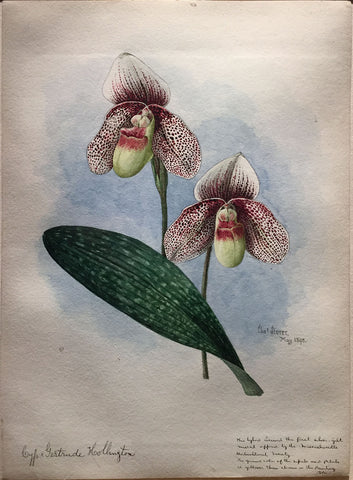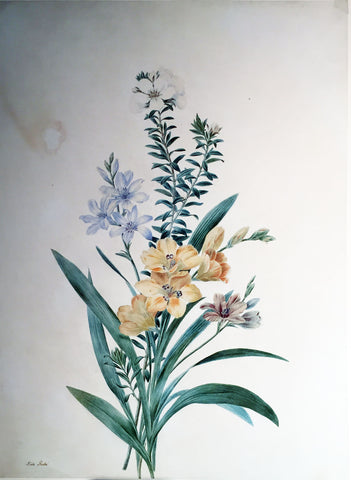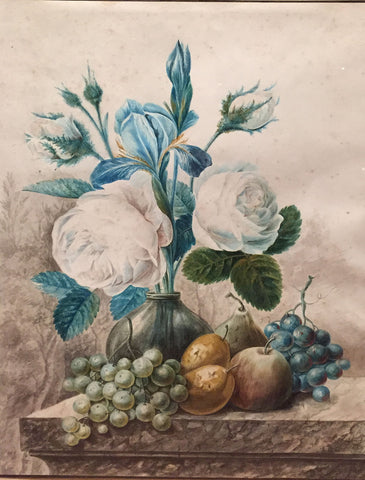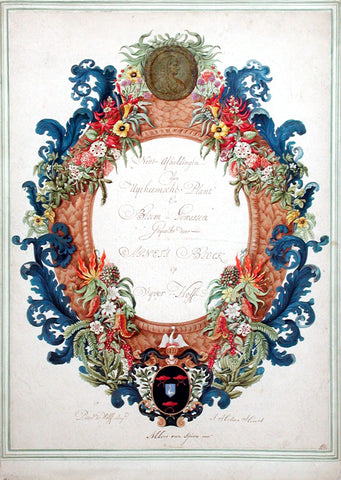
Charles Storer (American, 1817-1907) Cyp. Gertrude Hollington
Charles Storer (American, 1817-1907)
Cyp. Gertrude Hollington
Watercolor, ink and pencil on paper
Signed ‘Chas Storer 1898’ lower right
Paper size: 13 7/8 x 9 7/8 in
Frame size: 23 1/2 x 19 1/2 in.
Provenance: Donated to the Massachusetts Horticultural Society in 1925 by botanist Oakes Ames.
During the Victorian Era, orchid collecting was a very popular pastime. The fad began in England and eventually made its way to North America were amateur botanist grew unusual specimens procured from around the globe.
American artist Charles Storer was likely an orchid enthusiast and painter known for his finely details drawings of orchidae. We know Storer was born in Boston, 1817, but little is known of his life. It is recorded that he was a member of the Boston Art Club and exhibited at the National Academy of Design. Science was at the heart of his fascination with orchids, which seems evident from a September 1904 article in the Orchid Review, which states Storer provided them with a painting of an orchid not typically found in North America. The author stated that Storer was based out of Providence, Rhode Island, and had been studying orchids for over twenty-five years.
This incredible collection of Storer orchid watercolors was gifted to the Massachusetts Horticultural Society by famed botanist Oakes Ames (1874 - 1950), grandson of the wealthy businessman Oakes Ames Sr. The younger Ames fostered a love of orchids as a teenager, collecting rare specimens as early as age fifteen. Through his life’s work on the orchid family, he and his wife Blanche unveiled the mysteries of this strangely beautiful plant species to the rest of the world.
These gorgeous and delicate watercolors were part of Ames’ personal collection of orchid paintings, featuring works by the botanist himself, his wife Blanche, Charles Storer, J.L. Macfarlane, Putzys, and several by unidentified artists. With precision reminiscent of the great flower painter Redoute, each artist captures the unique shape and character of their subjects, producing works of unparalleled beauty with scientific accuracy. The genera represented in the Ames collection are Cypripedium, Cattleya, and Selenipedium, three of the most beautiful members of the orchid family. Cypripedium is a genus of 47 species with thousands of known hybrids, and the sole genus of the subtribe Cypripediinae. These orchids are terrestrial and hardy, growing primarily in colder climates of the Northern Hemisphere, in North America, Europe, and Asia. Some Cypripedium grow in the tundra in Alaska and Siberia, which is an unusually cold habitat for orchids. They can withstand extreme cold, growing under the snow and blooming when the snow melts. But, in the wild, most have become rare and close to extinction, due to an ever shrinking natural habitat and overcollection. Cattleya is a genus of 42 species of orchids, as well as many hybrids from Costa Rica to tropical South America. The genus was named in 1824 by John Lindley after William Cattley, who received and successfully cultivated specimens of Cattleya labiata that were used as packing material in a shipment of other orchids. They are widely known for their large, showy flowers, and were used extensively in hybridization for the cut-flower trade until quite recently. This genus and the numerous hybrids come close, through their beauty, to the iconic picture of the orchid. Selenipedium has been given its own tribe, Selenipedieae, and subtribe, Selenipediinae. Some of the species in this genus are characterized by long tendril-like petals.
Throughout his career, Ames assiduously studied and classified the Orchidaceae, bringing the plant species to the general public for the first time. Previous to his work, the Orchidaceae were little-known both within and outside of the field of botany. As part of his exhaustive research on orchids, Ames made expeditions to Florida, the Caribbean, the Philippines, and Central and South America with his wife, creating scientific drawings and watercolors of each plant they cataloged. The Ames’ work was published in the seven-volume Orchidicae: Illustrations and Studies of the Family Orchidicae. The couple also developed the Ames Charts, illustrating the phylogenetic relationships of the major useful plants, which are still used today.
Ames attended Harvard University, where he received his master's degree in botany in 1900. Immediately after graduating, he was hired as an Instructor of Botany, thus beginning a career of teaching at Harvard, which lasted 50 years. During this time, he built up an extensive orchid herbarium in the Botanical Museum of Harvard University with a library, photographs, and paintings, which he gave to Harvard in 1938. Today the Orchid Herbarium of Oakes Ames contains about 131,000 specimens, plus 3,000 flowers in glycerine, 4,000 pickled specimens, and hundreds of line drawings. Its library includes about 5,000 books, reprints, and journals. The Herbarium is one of the largest single-family herbaria in the world. Ames’ primary interest was in gathering scientific information rather than merely storing dried specimens in a depository. Consequently, the collection is vibrant not only in type specimens but also in records and transcripts of holotypes from institutions throughout the world.
Please feel free to contact us with questions by phone at 215.735.8811,
or by email at loricohen@aradergalleries.
We Also Recommend





